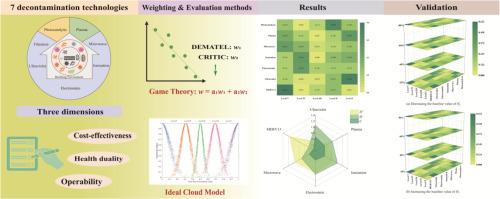利用DEMATEL-CRITIC组合加权和理想云模型对暖通空调系统净化技术进行综合可行性评估
IF 7.6
1区 工程技术
Q1 CONSTRUCTION & BUILDING TECHNOLOGY
引用次数: 0
摘要
在去污技术领域,以往的评价主要集中在去污率或经济性方面。现有的净化技术评价方法大多是一维的,缺乏系统的框架。提出了一种理想的云模型,以进行综合可行性评估,考虑成本效益、健康二元性和可操作性。采用决策试验与评价实验室(DEMATEL)法和标准间关联重要性(critical)法确定主客观指标权重,采用博弈论确定综合权重。以成都孵化园某办公楼为研究对象,对7种净化技术的综合可行性进行了评价。结果表明,从单一角度来看,等离子体技术具有最高的经济效益(52美元/平方米),紫外线技术具有更好的健康二元性(HI = 0)。在多维度评价中,紫外线技术是最优的,表明其具有良好的应用可行性。成本(0.259)和可操作性(0.214)具有最高权重,是净化技术的优先考虑因素。理想云模型的新颖之处在于它将云模型(CM)处理模糊信息的能力与TOPSIS (Order Preference by Similarity to ideal Solution)的排序优势相结合,从而为选择最优去污技术提供了一种现实有效的方法。稳定性分析表明,当模型参数超熵从基线值波动±20%、±40%、±60%和±80%时,评价结果保持稳定。本研究建立了一个综合的框架来评估净化技术的应用可行性,以支持知情决策。本文章由计算机程序翻译,如有差异,请以英文原文为准。

Comprehensive feasibility evaluation of decontamination technologies in HVAC systems using DEMATEL-CRITIC combined weighting and ideal cloud model
In the field of decontamination technology, previous evaluations mainly focused on decontamination rates or economies. Most existing evaluation methods for decontamination technologies are one-dimensional and lack a systematic framework. An ideal cloud model is proposed to conduct comprehensive feasibility evaluation that considered cost-effectiveness, health duality, and operability. The subjective and objective indicator weights are obtained using Decision-Making Trial and Evaluation Laboratory (DEMATEL) and Criteria Importance Through Intercriteria Correlation (CRITIC) approaches, while the combined weights are determined using game theory. A case study is conducted on an office building in Chengdu Incubation Park to evaluate the comprehensive feasibility of seven decontamination technologies. The results demonstrate that, from a single perspective, plasma technology presents the highest economic benefits (52 USD/m²) and ultraviolet technology shows superior health duality (HI = 0). In a multi-dimensional evaluation, ultraviolet technology is optimal, signifying its excellent application feasibility. Cost (0.259) and operability (0.214) possess the highest weights and are priority factors for decontamination techniques. The novelty of the ideal cloud model lies in its integration of the Cloud Model's (CM) capability to handle fuzzy information with the ranking advantages of the Technique for Order Preference by Similarity to Ideal Solution (TOPSIS), thus providing a realistic and effective method for selecting optimal decontamination technology. Stability analysis shows that when the model parameter hyper-entropy fluctuates by ±20 %, ±40 %, ±60 %, and ±80 % from the baseline value, the evaluation outcomes remain consistently stable. This research establishes a comprehensive framework for evaluating the application feasibility of decontamination technologies to support informed decision-making.
求助全文
通过发布文献求助,成功后即可免费获取论文全文。
去求助
来源期刊

Building and Environment
工程技术-工程:环境
CiteScore
12.50
自引率
23.00%
发文量
1130
审稿时长
27 days
期刊介绍:
Building and Environment, an international journal, is dedicated to publishing original research papers, comprehensive review articles, editorials, and short communications in the fields of building science, urban physics, and human interaction with the indoor and outdoor built environment. The journal emphasizes innovative technologies and knowledge verified through measurement and analysis. It covers environmental performance across various spatial scales, from cities and communities to buildings and systems, fostering collaborative, multi-disciplinary research with broader significance.
 求助内容:
求助内容: 应助结果提醒方式:
应助结果提醒方式:


